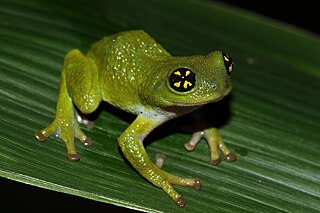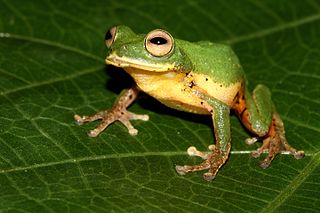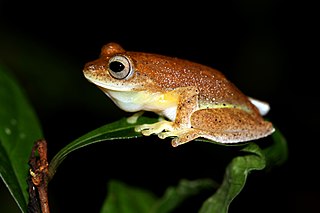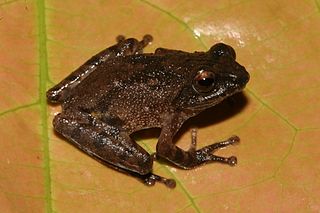
The Rhacophoridae are a family of frogs that occur in tropical sub-Saharan Africa, South India and Sri Lanka, Japan, northeastern India to eastern China and Taiwan, south through the Philippines and Greater Sundas, and Sulawesi. They are commonly known as shrub frogs, or more ambiguously as "moss frogs" or "bush frogs". Some Rhacophoridae are called "tree frogs". Among the most spectacular members of this family are numerous "flying frogs".

The Malabar gliding frog or Malabar flying frog is a rhacophorid tree frog species found in the Western Ghats of India.

Raorchestes chalazodes is a species of critically endangered frog in the family Rhacophoridae. Raorchestes chalazodes is a nocturnal and arboreal species found in the understorey of tropical moist evergreen forest and is endemic to the Western Ghats of India. The specific name chalazodes is composed of the Greek word χάλαζα (chalaza) meaning "lump" and -odes for the derived adjective, reflecting white granulation of the body. It has been observed between 1200 and 1600 meters above sea level.

Raorchestes flaviventris is a species of arboreal, nocturnal, frog of the family Rhacophoridae. It is endemic to the Western Ghats, South India. Its common names are yellow-bellied bush frog and Malabar bubble-nest frog.

Raorchestes luteolus is a species of frog in the family Rhacophoridae. It is endemic to the Western Ghats, India, where it is only known from the state of Karnataka. Many of the known populations are from the Kodagu district, known also by its anglicised former name of Coorg—hence the common name. It is also known from the Shimoga district in the Sharavathi basin where it was described as a new species, Philautus neelanethrus, but this is now considered to be a junior synonym of Raorchestes luteolus.

Ghatixalus variabilis is a species of frog in the family Rhacophoridae. It is endemic to the Western Ghats of southern India. It has a number of common names, including green tree frog, though it is terrestrial rather than arboreal in its life style.

Raorchestes anili, known commonly as Anil's bush frog, is a species of frog in the family Rhacophoridae.

Raorchestes is a genus of frogs in the subfamily Rhacophorinae that are found in mountainous regions of South Asia, Southeast Asia, and southern China. A recent study places Raorchestes as a sister taxon of Pseudophilautus. Before the description of the genus in 2010, species now in Raorchestes had been assigned to genera Ixalus, Philautus, and Pseudophilautus.

Mercurana is a genus of arboreal frogs belonging to the family Rhacophoridae. The genus was named from the only known species Mercurana myristicapalustris, which was described in 2013 from the Western Ghats of Kerala, India. The generic name was derived from and given as a tribute to Freddie Mercury, the late vocalist of the British rock band Queen, in combination with the Latin name for "frog". The frog is different from other related frogs in that it has extensively webbed toes, lives only in swampy lowlands, and lays its eggs on mud with which it carefully mixes leaf litter.

Ghatixalus is a genus of frogs in the family Rhacophoridae, subfamily Rhacophorinae. They are endemic to the Western Ghats of southern India. They are the sister taxon to a larger clade consisting of Chiromantis, Feihyla, Taruga, Polypedates, and Rhacophorus. The name of the genus combines words "Ghats" and "Ixalus". The former refers to the Western Ghats, and the latter to now-abandoned genus name that lives as the suffix in many generic names for rhacophorid frogs.

Raorchestes jayarami, also known as Jayaram's bush frog, is a species of frog from the subfamily rhacophoridae found in Valparai in the Western Ghats of Tamil Nadu in India, where it has been observed between 600 and 1800 meters above sea level.

Raorchestes johnceei is a species of frog of the genus Raorchestes found in Bonacaud in the Western Ghats of Kerala in India. It has been observed between 900 and 1300 meters above sea level.

Raorchestes kadalarensis is a species of frog of the genus Raorchestes found in Kadalar near Munnar in the Western Ghats of Kerala in India. This frog has been observed between 1300 and 1700 meters above sea level.

Raorchestes manohari is a species of frog of the genus Raorchestes found in Bonacaud in the Western Ghats of Kerala in India. The species is named after T. M. Manoharan, Principal Chief Conservator of Forests, Kerala.

Raorchestes ravii is a species of frogs of the genus Raorchestes found in Naduvattam in the district of Nilgiris in Tamil Nadu, India, about 1890 meters above sea level. The species is named after Ravi Chandran, an enthusiast from Wayanad who discovered the species.

Beddomixalus is a monotypic genus of frogs in the family Rhacophoridae. The only described species, Beddomixalus bijui, is endemic to the Western Ghats, India. Its name is derived from a combination of the cognomen of Richard Henry Beddome, in honour of his work on the amphibian diversity of the Western Ghats, as well as Ixalus, which is often used as a suffix for names of rhacophorid genera.

Raorchestes silentvalley or Silent Valley bushfrog is a species of tree frog endemic to the Nilgiri Hills of southern India and belongs to the species-rich Asian genus Raorchestes. The species was described in June, 2016 and has been found to have a very restricted distribution on the southwestern slopes of the Nilgiri Hills in the Silent Valley National Park. This frog has been observed 2100 meters above sea level in Silent Valley National Park.

Raorchestes hassanensis, the Hassan bush frog or Dutta's bubble-nest frog, is a species of frog in the family Rhacophoridae. It is endemic to India, including the Western Ghats.
Raorchestes lechiya, or Lechiyappan's bush frog, is a species of frog in the family Rhacophoridae. It is endemic to India. Scientists know it exclusively from the type locality: 2023 meters above sea level in Silent Valley National Park. This frog has been observed between 1800 and 2200 meters above sea level.

Ghatixalus asterops, the Ghat tree frog or starry-eyed Ghat tree frog, is a species of frog in the subfamily Rhacophorinae. It is endemic to India's Western Ghat mountains, specifically the Palani Hills and south of the Palghat Gaps.



















